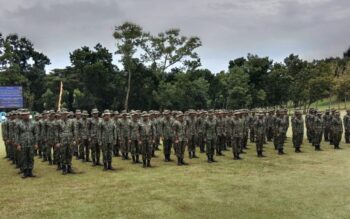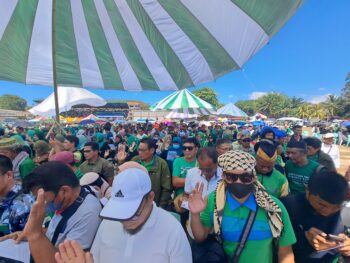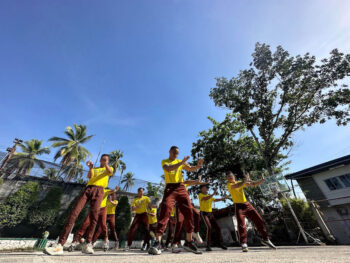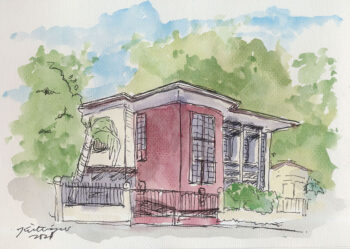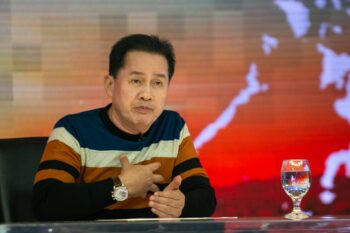
BOOK REVIEW – Kalandrakas Stories and Storytellers – A Preliminary and Continuing Survey and Literary Mapping
PART I – 1890-1945
PART II – 1946-1990
Editor – Ricardo M. De Ungria
Publisher – Ateneo de Manila University Press, 2022
CEBU CITY (MindaNews / 26 January) – Once in a rare while, a book appears on the horizon so unbelievably magical that it takes one’s breath away! It is as if a rare treasure drops down from the heavens handed down by the gods and goddesses who wish that the lesser mortals could open their eyes and realize how precious this gift is.
The gift that needs to be acknowledged and appreciated – especially for those of us who would claim to be Mindanawons (born and raised in Mindanao or have adopted Mindanao as their home) – is the rich legacy of writings of poets, essayists, playwrights and novelists written throughout a century from 1890 to 1990. The literary tradition of those writing on Mindanao – initially the early colonizers and migrants who inhabited Mindanao and later Mindanawons themselves – can now be easily accessed through the two volumes of KALANDRAKAS.
For those who do not understand Cebuano-Bisaya, kalandrakas means the following: miscellaneous, motley, varied, medley or constituted by things of all different kinds and varieties coming at once, or a conglomeration of various things or kinds. It is the perfect Mindanawon word to serve as title of this monumental work for KALANDRAKAS is a comprehensive collection of various varieties of literary output of 249 writers (100 in Part I and 149 in Part II). Their poems, short stories or excerpts from novels, essays and plays are included in this anthology written in the various languages for the authors include the American colonizers of the 1890s as well as Moro, indigenous peoples, migrant settlers and their descendants.
If there was ever any doubt that Mindanao has had a rich literary tradition which continues to flourish until today, KALANDRAKAS has once and for all debunked the pejorative belief of non-Mindanawons that there exists no literature in southern Philippines! For having done this, Ricardo de Ungria – KALANDRAKAS indefatigable Editor (but who also did the dirty work of collecting all these writings, scanning through them to decide which parts can be included, translating some parts and organizing the flow of the manuscript) – deserves a round of applause from all Mindanawons who owe him a big debt of gratitude for having accomplished this major literary publication that will serve present and future generations!
In the book’s back cover, one can read what this book is all about: “This is a collection of writings on Mindanao from 1890 to 1990. The year 1990 was chosen because that was the year the existence of a “Mindanao literature” was officially recognized through the ANI issue on Mindanao…From there, the book’s editor worked back a century to cover a hundred years of writings in the island. The book is divided into two periods – from the 1890s to pre-independence and the post-war till 1990 – with the former featuring the island’s colonial literature and the latter literally the post-colonial and the modern.
“The term ‘stories’ includes all genres of literature – including oral literature translated into English – published within the timeframe of the book, with a few exceptions. The whole anthology is an ongoing recuperative archival project intended to be picked up, continued, corrected, and enriched by writers, researchers, and educators in the island’s six regions for the initialization and sustenance of their own archives literary and historical awareness, and development of distinctive artistic practices independent of Western influences.
“Thus, the book includes a literary map that, based on available information, locates the storyteller’s herewith in the identified places in the regions where they were born, lived or worked or else passed through. It assumes that there are individuals and/or groups in the regions who care for their history, literature and the arts, as well as for the people involved in these endeavors, and who are willing to write and articulate their own local histories and respective arts and literatures and ways of reading and appreciating them in their own languages, hopefully, and gradually begin to wear their pride of place as badge of honor.”
This is a voluminous publication constituting 2,048 pages (883 for Part I and 1,165 for Part II) and one can understand why the two volumes are thick and quite heavy when you hold them. Not only are included the writings of the 249 writers but there are sections that include the Editor’s long Introduction, biographical notes of the writers, and various Appendices (which regions the writers are from, directory of Mindanao Writers and proposed framework for archival project and developing literatures in the Regions) as well as Bibliography. There are also important photographs inserted in the texts.
Going through the names of the authors included in this anthology in the two volumes one is impressed at the wide range of their personalities, ethnicities, genders, cultural and academic backgrounds. There are also works whose authors are no longer known and have to be identified as Anonymous. Some names stand out as they are the authors of historical and anthropological books listed as required readings of classes in various universities or whose works have been studied in literature classes. Many are unknown authors and one needs to check the biographical notes to get to know them.
Part I begins with the writings of three Cagayan de Oro writers identified as Capitan Tikoy, Capitan Miano and Capitan Bivo followed by the writings of Jose P. Rizal while the national hero was in Dapitan, Zamboanga del Norte. The last entry is that of Helen Follett who was from New York, a travel writer who wrote books for young adults. The familiar names of those in Part I include Najeeb Saleeby, Fay-Cooper Cole, Brig. Gen. John Pershing, Mrs. William Howard Taft, Laura Watson Benedict, Dr. Sixto Orosa, Frank Laubach, Datu Gumbay Piang, John Garvan, Alice Worcester Day, and Maximo Ramos.
There are naturally more familiar names in Part II as this section covers the contemporary era. Among those named are writers who were also politicians, businessmen, professors and journalists. Names familiar to most of us include Reuben Canoy, Ibrahim Jubaira, Princess Tarhata Kiram, Aida Rivera Ford, Saturnino Apoyon, Cesar Abdul Majul, Kerima Polotan Tuvera, Eric Casiño, Sr. Delia Coronel ICM, Jean Edades, Peter Gowing, Resil Mojares (to whom the Editor dedicated this book), Jose Angliongto, Francisco Demetrio SJ, Horacio Paredes, H. Arlo Nimmo, Leoncio Derida, Mamintal Tamano, Rita Tuban, Noralyn Mustafa, Don Pagusara, Samuel Tan, Mac Tiu, Rita Gabi, Carlota de Pio, Mardonio Lao, Christine Ortega, Jose Ayala, Alfredo Navarro Salanga, Erlinda Burton, Albert Alejo SJ, Abdulmari Imao, Victorino Saway, Francisco Sionil Jose, Rudy Rodil and Greg Hontiveros. But side by side with these distinguished authors are also the Binukid storytellers (Anastacio Saway, Amay Tambagon, Nema Balmores et al) whose oral literature are documented in this book.
One can get overwhelmed by just scanning through the countless pages of the two volumes of KALANDRAKAS. It would take years for readers to be able to read this book from cover to cover. But if they have the patience to spend time reading through the texts, they would realize just how rich Mindanao’s literature is! And they would see how privileged they are to have access to this publication which is the product of de Ungria’s tenacity of assembling all these works in just two volumes. One can imagine the hours that De Ungria spent from the moment he conceptualized this project to collecting the works, interviewing the authors, annotating and translating the texts, editing and seeing to the final publication of this book.
This book is so valuable in popularizing and promoting Mindanawon literature that every library throughout Mindanao and every Literature teacher should have a copy of the two volumes. However, given the financial limitations of school libraries and teachers of public schools and colleges, the DepEd and CHED should budget funds to make sure they are provided at least one copy each. Private educational institutions and funding institutions interested in promoting literacy and culture might also be enticed to purchase copies of the book for distribution to public libraries and schools.
One interesting trajectory of the two volumes is that in Part II, a significant number of authors in Part I were either mainly American colonizers or those whose locations and residences were outside of Mindanao. In Part II, there are still American authors or Filipinos living abroad or from Manila, but more and more the writings are those born and raised in Mindanao. And significantly there are more Lumad and Moro writers contributing. Clearly this has been a trend in the past few decades; as there are fewer books written by outsiders, more are written by the locals and indigenous. Carol Arguillas of MindaNews who has been documenting publication on Mindanao in the past few years has noted this phenomenon.
De Ungria explains why this is an important development as he wrote in his Introduction: “We need to know more of our own writers and thinkers and engage with their own writings and thoughts instead of favoring those of other countries with different cultures and modes of thinking from us. This is the only way we can sustain a tradition or traditions of our own and help communities develop attention, respect, and esteem for the writers and artists in their midst without needing contests or prizes to do so. I hope for Mindanawon writers to find some shards of insights from the works of the past that can stimulate and sustain, on artisan artistic practice and scholarship for the nonce, a body of writings true and responsive of the needs of their respective communities and should no longer left behind in ignorance of and indifferent to the arts. They should learn how to modernize without or with less Westernizing, developing ways of appreciating the arts based on their own values and needs, disposing of the plasticity of hierarchies and the canons of meritocracy and keeping the literary and artistic landscapes flattened, respecting the variety of cultures in their midst, and simply accommodating and enjoying one another’s creative company with the support of a responsive community and in full awareness that in this land of diversity, there is a voice for everyone and a place for works of all kinds.”
The reader is now challenged to spread the word that such a book is now available for sale through ADMU Press and the various outlets for ordering books these days. One can order either Part I or Part II only, but it is best to order the two volumes.
(MindaViews is the opinion section of MindaNews. Redemptorist Brother Karl Gaspar is Mindanao’s most prolific book author. Gaspar is also a Datu Bago 2018 awardee, the highest honor the Davao City government bestows on its constituents. He recently moved to his new assignment in Cebu City.)

